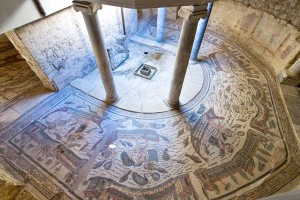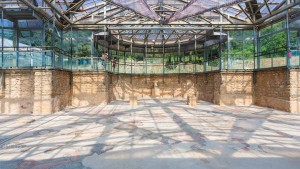
©Bigstock.com/lachris77
Starting in Roman times, the wealthy population would occasionally retreat to the countryside to relax and leave behind the hectic city life turning the villa urbana, a luxurious estate and part-time residence outside the city walls into a must-have as early as pre-Christian times. Villa Romana del Casale, located near Piazza Armerina in Sicily, is one of the best-preserved estates of the Late Roman period and well-known for its fascinating architectural insights and splendid mosaic floors. This monument of Roman Sicily was even declared UNESCO World Heritage Site in 1997 and absolutely needs to be part of your travel itinerary.
What we know about the villa’s history
The era of the Roman Empire initially proved to be difficult for Sicily. Slave labour on the latifundia led to abandoned estates and a noticeable decline in city life. Increasing importance of the Provinces of Tripolitania and Africa as grain suppliers gave a decisive boost to Sicily in the early 4th century turning it into the main trade centre between the continents. New wealth allowed certain classes to live in the countryside where the magnificent villas were now being built by colonates.
Unfortunately, we don’t know who Villa Romana del Casale originally belonged to. While it was initially believed to be the imperial residence of either Maximian or his son Maxentius, other theories settled on a governor or consul. Even the exact period of origin remains unclear. Experts put it somewhere around 310 to 325 BC. However, the mosaics likely date back to the second half of the fourth century. Nevertheless, researchers are now almost certain that Villa Romana del Casale was originally privately owned.
Rediscovery and excavations
Like so many other Roman buildings, Villa Romana del Casale initially got lost to the turmoil of history. It was inhabited during the Byzantine reign over Sicily. Later, an Arabic colony was built here which, in turn, was destroyed by the Normans in the 12th century. Ruins of the villa were only discovered in 1761 and first thought to be relics from the aforementioned Arabic period.
Once Robert Fagan got his excavations, which were eventually kicked up a notch by Luigi Pappalardo in 1881, under way, the true nature of this architectural treasure of immeasurable value soon became clear. Three additional excavations throughout the 20th century unearthed the entire complex. The entire villa had been excavated in 1954, last digs took place as late as 1985. Even minor landslides and vandalism couldn’t harm the villa complex with its splendid mosaics.
Exploring Villa Romana del Casale

©Bigstock.com/vvoevale
The villa urbana is particularly well-known for its excellently preserved mosaic floors. A landslide proved to be a stroke of luck as it buried the mosaics in the 12th century preventing weathering, looting and destruction. They were even re-buried after initial excavations to protect it from any and all external influences. Later years saw the construction of a villa-like building serving as a full mosaic roofing. Nowadays, you can sneak a peek at the amazing mosaic rooms from the footbridges on the ancient walls.
While the mosaics are most certainly the ultimate highlight of Villa Romana del Casale, there’s so much more to see and discover throughout this impressive complex. You absolutely must check out the following rooms and areas:
- Entrance area with vestibule: The mighty three-arched gateway leads you into the courtyard and to the vestibule. The partly preserved arrival scene depicts the expecting of an important guest.
- Rectangular peristyle: The characteristic Corinthian pillars of the first peristyle lead to the floor mosaics with animal heads that change orientation in two places – likely to highlight the different routes leading through the villa.
- Peristyle rooms: A great number of service rooms, private apartments and bedrooms await you around the rectangular peristyle. The Hall of Seasons is vested with corresponding depictions, other areas feature grand hunting mosaics.
- Basilica: Four steps lead you into a large hall with an apse flanked by two pillars. It is believed that visitors used to be received here due to the eye-catching floor design made of coloured marble and porphyry. Whether the Basilica actually served a liturgical purpose remains unknown.
- Private apartments: Find several private sets of rooms around the Basilica in the eastern part of the villa. While the smaller area likely belonged to the landlady or the son, the larger area probably served as the landlord’s quarters. Once again, you’ll be amazed by extensive mosaic works depicting hunting scenes and different gods.
- Elliptical peristyle: Enter this complex with pillars, three apses and a fountain via the rectangular peristyle or the Corridor of the Great Hunt. The medallion with a male bust – it could be the personification of autumn – is similar to a mosaic in the mausoleum of Santa Constanza created a few years later.
- Thermae: The villa entrance leads directly to the complex of thermal baths that, as such, could also be accessed by guests that weren’t led into the private apartments. However, there was also a separate tenant entrance. Pool, gymnastics and changing rooms display maritime motives. Another mosaic might depict the landlady with two children and two servants.
Corridor of the Great Hunt
All these fascinating rooms and areas aside, there’s one truly special corridor. The Corridor of the Great Hunt used to connect the private and the public part of the villa across just under 66 m. Its slight elevation and the portico leading from the middle to the peristyle emphasise the importance of this splendid corridor with its impressive mosaic floors.
The Great Hunt actually depicts mostly non-violent scenes of capturing animals for games in Rome with weapons only serving the purpose of self-defence. Seven different scenes, designed by at least two different groups of mosaicists, can be identified. It starts with the capturing of animals in different parts of the Province of Africa before moving on to Egypt and India. Transportation and loading scenes and the killing of an attacking lion can be seen as well. Character displays and stylistic plurality mark the gradual transition from Roman to Byzantine art. Taking the peristyle room mosaics into account, the Corridor of the Great Hunt might suggest that this estate could’ve also been a hunting manor.
This unique villa urbana in the Province of Enna conveys fascinating insights into the later history of Rome, Sicily’s trade hub boom and the life of the wealthy class in the fourth century. You will most certainly be enthralled by the multifaceted mosaics and diligently restored corridors and buildings – don’t miss out on visiting Villa Romana del Casale during your next holiday!